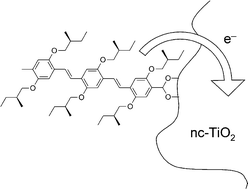TiO2 sensitized with an oligo(p-phenylenevinylene) carboxylic acid: a new model compound for a hybrid solar cell
Abstract
The interaction of an acid-functionalized oligo(p-phenylenevinylene)
(OPV3-COOH) with nanocrystalline TiO2 has been studied as a model for semiconducting


 Please wait while we load your content...
Please wait while we load your content...